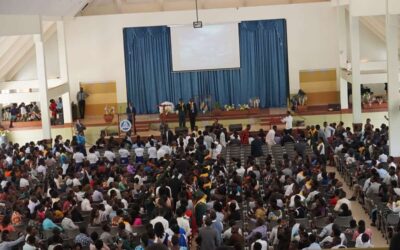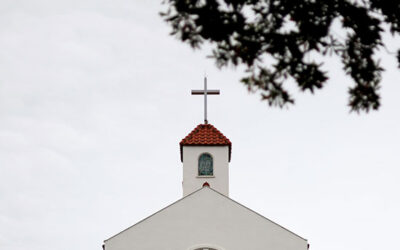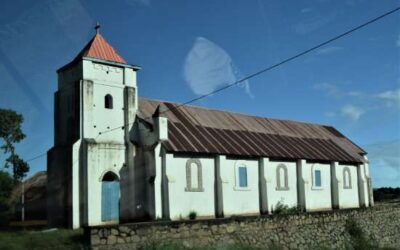Sabbath School is the Bible study component of the church program at most Seventh-day Adventist Churches. It’s a time of Bible study on a specific topic or lesson. Instead of listening to a preacher, people interact with one another, making it a great opportunity for building friendships.
Your Adventist friend or relative may have mentioned Sabbath School. Or perhaps you saw a sign for it outside a local Adventist Church.
Curious? Let’s walk through the experience together. By the end, you’ll have everything you need to know to try it out for yourself.
We’ll cover:
What is Sabbath School?
Sabbath School is like a small group Bible study that takes place on Sabbath mornings (Saturday) in addition to the main service at an Adventist Church. It’s the equivalent of Sunday school for other Christians, and it’s offered for all ages: from babies to elder adulthood.
Both church members and guests are welcome to take part, learn, and grow in their faith during this time.
So what does Sabbath School entail?
It has three main purposes:
Bible Study

Photo by Hannah Busing on Unsplash
The Adventist church’s motto for Sabbath School is “the church at study.” During this time we dig into the Bible, sharing insights and grappling with challenging topics. The focus is not on having all the answers, but turning to God and seeking the answers in His Word as the Holy Spirit guides us.
In this way, we grow in our faith journeys as we share with others and learn from them.
When you attend for the first time, you may want to just observe and listen, and that’s totally fine! But if you want to speak up, your questions and thoughts will enrich the Bible study time. Hearing the experiences and testimonies of others shows us how God is still working in people’s lives today.
Connection
 The Bible says a lot about the importance of community. We need one another. And Sabbath School’s second purpose is to build that sense of community. It’s a great time to interact, get to know one another, and offer encouragement. Being open and honest is key.
The Bible says a lot about the importance of community. We need one another. And Sabbath School’s second purpose is to build that sense of community. It’s a great time to interact, get to know one another, and offer encouragement. Being open and honest is key.
Unlike the main church service time, Sabbath School lets all participants share what’s on their hearts. We don’t just sit and listen to one person speak.
Small groups make this possible. Depending on the church, attendance can be 5-10 people or 20-40 people. Churches in larger areas sometimes split classes to make sure they stay small enough for discussion.
The atmosphere in Sabbath School is much more relaxed so people feel comfortable expressing their thoughts.
Mission
Churches often use the Sabbath School time to highlight local and global mission projects. In some classes, participants may even band together and reach out to their community.
For example, they might decide to visit people who are sick or volunteer at a soup kitchen on Sabbath afternoon. Or they might pool money together to sponsor a child. There are all kinds of possibilities.
In short, Sabbath School allows us to come together, dig into God’s Word, and serve our world and community. It follows the model of the early Christian church, which gathered in small groups for Bible study and fellowship:
“And they devoted themselves to the apostles’ teaching and the fellowship, to the breaking of bread and the prayers” (Acts 2:42; also verses Acts 2:46–47, ESV).
Jesus Himself taught His disciples in small groups (Matthew 24:3; Mark 9:28), and He promised this:
“For where two or three are gathered in My name, there am I among them” (Matthew 18:20, ESV).
What happens during Sabbath School?
Sabbath School usually begins in the mid-morning hours, anywhere from 9am to 11am depending on the church, and it runs for about an hour and 20 minutes. Most of this time is for Bible study. But at many churches, it starts with other activities, such as song service, a mission report, and prayer.
Let’s go through the full experience.
Sabbath School begins

Photo by C k
Most churches begin Sabbath School with a preliminary program with everyone gathered together.
And in some larger churches, there are two different church services so they can accommodate all their members. Then there’s time for Sabbath School in between. That way no matter which church service you attend, Sabbath School can still be easily included in your morning schedule.
But for this example, we’re going to walk in the door at 9:30 a.m.—a common Sabbath School start time.
We’ll make our way to the sanctuary—the main seated gathering area of the church—where the preliminary program is taking place. People typically meet here first.
As we enter, we can already hear the sound of singing. A couple more songs are sung before the coordinator for the morning (known as the Sabbath School superintendent) stands up to welcome everyone and pray. This individual announces that a mission report will be shared next.
This will usually be read aloud to the congregation. On some Sabbaths, mission story for the week from the Youth and Adult Mission booklet may be read.
Afterward, the superintendent makes some announcements, shares a Bible passage, or reads a spiritual thought before dismissing everyone to their classes.
Small group time

Photo by Kampus Production
The most important part of Sabbath School takes place when small groups gather to dig into God’s Word.
It’s close to 10 a.m. now, which means that the groups will have about 45 to 50 minutes together.
Some adult classes meet in the sanctuary area, while others have separate rooms. We make our way to a circle of chairs and sit down with a group of about 10 people.
Whoever is leading the Sabbath School class will greet everyone, maybe chit-chat a bit, and ask whether anyone has prayer requests. These few minutes of conversation help break the ice and connect the participants.
Then the teacher prays, asking for the Holy Spirit to lead, and we dive into the week’s lesson.
What do we study?
The class might study a certain topic or book of the Bible, or even read through the Bible together. But in many Adventist churches, the teacher will lead a discussion through the Sabbath School lesson study guide.
Let’s learn about that next.
What are the Sabbath School lesson study guides?

Photo by Joel Muniz on Unsplash
The Adventist Church produces the official Adult Bible Study Guide for use during Sabbath School. It is often referred to as “the lesson” or “the quarterly,” which comes from the word quarter because it’s intended for one-quarter of the year (3 months or 13 weeks). During that quarter, each week’s lesson digs into various aspects of a chosen topic or book of the Bible.
For example, one whole lesson quarterly might focus on the book of Matthew. Another might be on the topic of the Body of Christ, family relationships, the fruits of the Spirit, etc..
The Sabbath School lesson quarterly has one page for each day. The page provides Bible verses for the individual to look up and questions to answer along with some explanation.
Many classes go day by day through the previous week’s lesson and discuss what they learned.
But don’t worry—even if you weren’t able to study the lesson for the week, you’ll still be able to follow along and enjoy the discussion.
What should I bring to Sabbath School?
All you need to bring is yourself and a willingness to learn—really, it’s that simple. But some also like to bring their Bibles and a copy of the quarterly.

Photo by Aaron Burden on Unsplash
The Sabbath School lesson quarterly is usually handed out the Sabbath before the beginning of the new quarter. (Quarters begin in January, April, July, and October).
If you weren’t around to receive one, chances are that there are extras lying around on a table in the church’s entryway. And if not, you can access the Sabbath School lesson online or on a Sabbath School app on your smartphone.
Sabbath School offering
During the Bible study, the teacher may pause the lesson to pass around a couple of envelopes for the Sabbath School offering if there’s a project in need of support. An “offering” is a voluntary gift of money to help support various causes in the church. This offering is collected in all the classes, including the ones for children.
You may notice that there are two envelopes. One is for Sabbath School expenses, such as the purchase of Bible study guides.
The other envelope is for the mission offering and goes to support a region of the world church that has been selected for the quarter (the same region that the “Mission Spotlight” highlighted).
But no pressure—you are not required to give.
Giving an offering is up to you and what God places on your heart (Exodus 35:22); it is different from tithe (Malachi 3:10), which involves returning ten percent of our income to God.
What is the 13th Sabbath offering?

Photo by Annie Spratt on Unsplash
The 13th Sabbath offering is a term for a special collection of money on the last Sabbath of the quarter—the 13th Sabbath. On that day, churches worldwide support a specific mission project chosen by the Adventist Mission department of the General Conference.
Aside from the collection of the offering, the children’s classes may put on a special program during the preliminaries. They may present a song or skit that relates to the region of the world where the mission project is located.
Sabbath School is over for the morning
Often you’ll hear some sort of signal at the end of Sabbath School around 10:50 a.m. The main church service will soon begin.
Our teacher makes some closing remarks before wrapping up with prayer. We spend a few moments chatting with people as we gather our belongings and head to find a seat for the main service.
We’ve finished our adult Sabbath School experience, but you may be wondering about the classes for children.
Let’s look at the different options in a typical church.
What are the Sabbath School options for different age groups?
Most Adventist churches have Sabbath School classes for both adults and children. These classes are divided by age or stage of life to provide appropriate content and opportunity for fellowship. There are three main categories: children, youth/young adults, and adults.
But larger churches break these categories up even more.
Occasionally, there are more specific classes for adults: a class for women, a class for college students, or a class for people who are wanting to prepare for baptism.
The children’s classes are also further divided as follows:
- Cradle Roll or Beginners (birth–age 2)
- Kindergarten (ages 3–4)
- Primary (ages 5–9)
- Junior (ages 10–12)
- Earliteen (ages 13–14)
- Teen/Youth (ages 15–18)
So what happens in the children’s classes?
The Adventist Church provides Bible-based materials for each one. Teachers may choose to use these as the basic outline for their classes.

Photo by Ismail Salad Osman Hajji dirir on Unsplash
The Beginners class is the most interactive of all. Usually, the classroom will have decorations and props to match a theme, such as heaven or Creation. Throughout the program, the teacher reads short scripts, interspersed with songs and activities for the children to do.
The class will also have a storytime, using visual aids to catch the children’s attention. Traditionally, many Adventist children’s Sabbath School classes used felt boards—boards on which cloth cut-outs of characters and objects could be placed to tell a story.
The Kindergarten and Primary classes also use play and objects to interact with the children, though by this age, they can understand and participate much more. The teacher might give them pictures to color or crafts to make, too.
As the students become older, the classes shift from hands-on activities to conversing and engaging on a deeper level. The focus is applying the Bible’s principles and stories to the lives of the children and young people in each age group.
For each class—from the smallest children to teenagers—the Adventist Church has produced take-home materials that include age-appropriate Bible stories and character-building lessons.
How to find a Sabbath School near you
Now that you know more about Sabbath School, all that’s left for you to do is experience one in person! The Adventist Church’s website has a useful tool that allows you to find a church in your area. Once you find one, check its website or Facebook page for service times.
You can also bring Sabbath School to your home. Download the Sabbath School lesson at the Adult Bible Study Guide website. This way, you can follow along with what churches across the world are studying. You may even be able to catch the live stream of your local church’s services.
Many online programs follow the same study guide too, providing insight and discussion on the week’s lesson. Here are some of the most popular:
No matter where you are, you can enjoy the blessings of exploring God’s Word!
Sabbath School is for everyone

Photo by Adedotun Adegborioye on Unsplash
Sabbath School provides a setting for people of all ages to connect, study the Bible, and fulfill the mission of the worldwide church.
The Bible study guides help unify people across the globe as they delve into the same lesson.
And the structure of Sabbath School allows people to get to know Jesus and each other better as they come with their questions and thoughts. During this time, friendships can bloom and spiritual growth can happen.
Whether you’re a teen or a young mother or a retiree, there’s a place for you!
That’s what it’s all about:
Joining with others to dig into biblical truths that are relevant to our lives and the mission of sharing Jesus Christ.
Ready to check things out for yourself?
More Answers
Does the Adventist Church Have Youth Ministry Programs?
Does the Adventist Church Have Youth Ministry Programs?The Seventh-day Adventist Church has been organizing and operating youth ministry programs since 1879. In our opinion, youth ministry is one of the most important ministries a church can have. Being a tween or a...
How does one become a Seventh-day Adventist?
To be a Seventh-day Adventist Christian means to accept Jesus Christ as Lord and Savior. This means to recognize that Jesus alone can save you from sin and death (Savior) and to give Him full authority over your life (Lord and Master).
What Are Adventist Evangelistic Meetings?
The Seventh-day Adventist Church puts a huge emphasis on sharing the gospel through evangelism, or sharing the gospel through preaching, teaching, and testimony. One of the ways we accomplish this is by organizing public events called evangelistic meetings.
What Do Adventists Offer for Young Adults?
What Do Adventists Offer for Young Adults?In recent years, the age group often classified as “young adults” has been trickier to engage. It’s been a significant concern for Christian churches around the world. Though interestingly enough, similar observations...
Does the Seventh-day Adventist Church Believe in Paying Tithe?
Seventh-day Adventists believe in paying tithe and offerings based on the biblical command and our commitment to being wise stewards of God’s resources. These donations help fund the mission of the Adventist Church by supporting pastors, missionaries, church expenses, and evangelistic projects, among other things.
The Leadership Structure of the Seventh-day Adventist Church
The Leadership Structure of the Seventh-day Adventist ChurchThe Seventh-day Adventist Church has a representative form of structure that connects its 90,000-plus congregations across the globe and gives its members a part in decision-making. Though the Church was...
Seventh-day Adventist World Population and Demographics
Did you know that the Seventh-day Adventist Church has more churches around the world than all the Pizza Hut, McDonald’s, and Subway restaurants combined?
Do I Need to be an Adventist to be Saved?
The answer to this question is simply, “no.”
All about Adventist Elementary Schools
The Seventh-day Adventist Church operates the largest Protestant education system in the world. A big part of this system is our K-8 elementary schools, or primary schools, as they’re known in other parts of the world.
What Is Vespers?
Friday rolls around, and you’re spending time with your friends or relatives when they mention they’re going to vespers this evening.
Do Seventh-day Adventists Believe in Medical Care?
Adventists talk a lot about health principles and disease prevention. But how do we handle sickness and medical needs when they inevitably come along?
Do You Have to Be Vegetarian to Be Adventist?
Of course not. Membership in the Seventh-day Adventist Church has never included any dietary requirements.
How Do Adventists Do Baby Dedications?
For Christians, dedication ceremonies for babies are a special and memorable time for parents and the church. They often happen during a congregation’s main worship service when parents present their child before God and the church community, similar to how families did in the Bible.
What to Expect When You Go to an Adventist Church
If you’re attending an Adventist church for the first time, you may wonder what it’s really like. While each Adventist church is unique in its collective personality and local culture, Adventist church services are generally similar to most other Protestant Christian church services.
Everything You Need to Know About Sabbath Meals
For Seventh-day Adventists, sharing a Sabbath meal with friends and family is one of the most special and memorable parts of the Sabbath.
Why do Adventists Emphasize Religious Liberty?
Adventists see religious liberty as an essential human right. After all, God endowed humanity with freedom of choice from the very beginning. So we believe it’s best for governments to also support their citizens’ rights to worship based on their convictions.
All About Seventh-day Adventist Colporteurs
The Seventh-day Adventist Church uses a variety of methods to spread the hope of the gospel to the world. One of these ways is through colporteuring, also called “canvassing” or “literature evangelism.”
The Benefits of A Seventh-day Adventist Academy
Adventist academies are high schools (grades 9-12) that are owned and operated by the Seventh-day Adventist Church.
Who Are Adventists
The Seventh-day Adventist Church—“Adventists” for short—is a Christian denomination of ordinary people who seek to follow Jesus and live out His mission in this world. Established in 1863, we hold to the Protestant principle of sola scriptura, which means the Bible guides everything we do.
Evangelism
Evangelism is simply sharing the truths of the Bible with someone else. And Adventists are all into it.
Adventist Pastors
What is the role of a pastor in the Adventist Church?
Do Adventists Celebrate Christmas?
In many parts of the world, Seventh-day Adventists celebrate Christmas as a way to remember the birth of Christ. In certain parts of Africa, though, Christmas is much more low-key for Adventists, having less to do with religion and more to do with family time.
What Is ASI (Adventist-Laymen’s Services and Industries)?
ASI, which stands for Adventist-laymen’s Services and Industries, is a membership-based organization that provides support for Seventh-day Adventist laypeople (Adventist professionals who aren’t pastors).
Sola Scriptura—What Does It Mean, and Why Is It So Important?
Sola scriptura is a term that originated during the Protestant Reformation. It represents the way many Christians view the Bible and its authority.
What is the Concept of “Present Truth” and Why is it Important?
Present truth is the principle that certain biblical truths are relevant to God’s people at specific times in history. God sends the Holy Spirit to reveal truths that help us better understand how to interpret and apply His Word in a present moment.
What Does the Bible Say About Modesty
The Bible teaches that modesty, a form of humility and respect, is a valuable quality in everyone—men, women and children. It has to do with how we present ourselves, which should exemplify our inner relationship with God.
13th Sabbath Offering: What It Is and Why It Matters
On the last Sabbath of every quarter, Adventist churches participate in the 13th Sabbath offering—a special offering that goes to mission fields around the world.
Adventist Movies: Where Faith and Film Meet
The Seventh-day Adventist Church’s mission from the beginning has been to share God’s truth in the Bible. And as times have changed, we’ve explored new ways of doing this—one of those being movies.
Everything You Need to Know About an Adventist Church Potluck
Every so often, usually on a schedule ranging from once a week to once a month to once a quarter, an Adventist church will have “fellowship dinners,” often casually referred to as potlucks.
Didn’t find your answer? Ask us!
We understand your concern of having questions but not knowing who to ask—we’ve felt it ourselves. When you’re ready to learn more about Adventists, send us a question! We know a thing or two about Adventists.





























